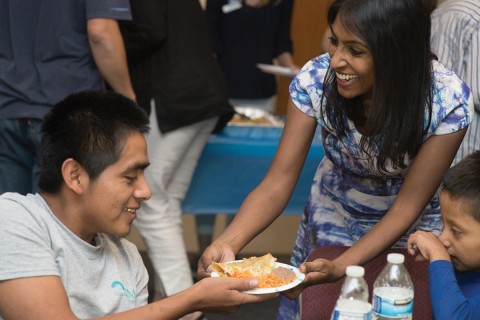Rebuilding refugee resettlement to make it better than it was under Trump—or Obama
“The last four years were incredibly hard. But we also know that the system was not perfect four years ago.”

Lutheran Immigration and Refugee Service president and CEO Krish O’Mara Vignarajah is a native of Sri Lanka who came to the United States as a nine-month-old refugee. She served in the Obama administration as a part of the First Lady’s Let Girls Learn initiative and coordinated refugee programs for the State Department. She joined LIRS as president in 2019. LIRS is one of nine private, mostly faith-based organizations that partner with the federal government to resettle refugees.
What have the last four years been like for a refugee resettlement agency?
Suffice it to say that the last four years have been a concerted effort to decimate the refugee resettlement system in the United States. We saw it first in the cuts to the refugee resettlement ceiling: setting a record low number became an annual tradition for the administration, ultimately leading to an 85 percent cut in refugee admissions.
Read our latest issue or browse back issues.
We also saw this in the xenophobic bans that targeted and excluded Muslims at a time when the most dire global displacement crisis in history disproportionately impacted Muslim-majority countries.
We also saw the issuing of an executive order that gave states and localities the authority to opt out of refugee resettlement. This essentially amounted to an invitation from the White House for politicians to play politics with some of the most vulnerable children and families in the world. That is why LIRS, along with other resettlement agencies, sued the administration and won an injunction against this order.
The last four years were incredibly hard. But we also know that the system was not perfect four years ago. Our hope is that we will rebuild a better system.
What are some of the immediate things the new administration can do?
President Biden has proposed a task force focused on family reunification as an urgent priority. He has been explicit in his commitment to returning the refugee resettlement number to 125,000.
Some things are easy to reverse, like the Muslim ban and stopping construction along the border wall. But there are other things that are more difficult. For example, it is going to be a little more complicated to get the border situation straightened out. I think they are trying right now to assess what the infrastructure is and to get the protocols in place.
How do we improve refugee resettlement in the US?
I would highlight three changes to the refugee resettlement structure.
Given the unprecedented number of displaced people worldwide, we should consider an annual admissions refugee floor—not just a ceiling. This idea was included in a House bill called the GRACE Act, which would set a minimum of 95,000 refugees per fiscal year. That number represents the historic average since the beginning of the program in 1980, if you average across all administrations before this last one.
This would help insulate the program from the political winds, and it would protect refugees from becoming the victims of political cudgels. This is not an abstract concern. The politicization of this program is completely unnecessary. People don’t realize that we have resettled more refugees under Republican administrations than under Democratic ones. President Reagan resettled the highest number of refugees.
Second, we can do an even better job of community cosponsorship of refugees. Canada took an idea that we initially piloted and ran with it, and it is interesting to see just how robust a program it has become there. We can do better in our work to cosponsor with churches and community groups to support new refugees—and in that way create shared responsibility for helping families and individuals integrate into the community, develop language skills, find employment. There are so many communities and congregations that are enthusiastic about this work.
The final thing I would highlight is the devastating effects of the climate crisis, leading to more refugees worldwide. We are already seeing it here off the coast of Louisiana and in places like Shishmaref, Alaska, where communities are forced to flee because the land where they live will no longer exist. As of right now, there is no legal or policy framework that even recognizes the concept of a climate refugee. Last year Senator Markey introduced a bill to open up 50,000 slots for climate refugees. In other words, he suggested creating a separate allocation for people displaced by climate change. This isn’t something that we get decades to plan for. It is a reality we face today.
What does LIRS’s work look like on the US-Mexico border?
Before asylum seekers were denied access to the United States, our border program provided shelter and resources using churches and community-based organizations. It was a beautiful program. This was an effort that drew volunteers and resources from all across the country.
When my family fled Sri Lanka, it was on the brink of civil war, divided along religious lines. So to me, the idea of a country where you have Lutherans working alongside Episcopalians working alongside Catholics working alongside Jews working alongside those who may not have a faith is deeply moving. That ecumenical response is such a core part of who we are as a country, a country that feels moved to welcome the stranger.
There are tens of thousands of people camped at the US border in an unsustainable situation. There are children who are being rejected at the border in violation of US and international law. When you hear officials say things like, “We don’t have the capacity to accept children,” that simply isn’t true. We at LIRS have the infrastructure to accept both children and families into our alternatives to detention programs. When it comes to unaccompanied minors, we have unique expertise in this area. We are one of only two agencies that resettles unaccompanied minors, and we have a long history of taking them into our care and shepherding them through a complex system. Our hope is that we can start rebuilding this infrastructure now.
We’ve successfully piloted several programs that have shown near perfect compliance with all immigration requirements and enforcement. We’ve found community-based resources for families, and we’ve done it at a fraction of the cost of detention.
Tell us more about your alternatives to detention programs.
I feel so deeply about how broken our detention system is. We have over 50,000 people in immigration detention centers held at any one time. The tragedy with the pandemic is that parents are being faced with an impossible choice: keep a child in their own care, but incarcerated, while COVID remains a danger in those settings, or release a child into who knows whose custody with who knows what care. There is a viable alternative that is not exercised enough: release the entire family into a program like alternatives to detention.
It is a tragedy that private prison companies that were pushed out of the domestic penitentiary system because of criminal justice reform looked to immigration as the new profit center. It is not surprising, the dynamics and trends that we are seeing: private prison companies operate about 80 percent of the beds in the immigration system. CoreCivic and the GEO Group, the top two, made $1.7 billion last year in contracts. Equally horrifying to me is that companies like Halliburton are profiteering off of the well-being of children in places like Homestead in Florida, basically a warehouse for children. This is reprehensible.
When I visited Homestead, they had 144 children sleeping in one room, and they claimed that the kids like it because it is like a slumber party. When they said that, it felt like a preemptive statement because they saw our horror.
But these private prison companies are savvy. They have also gotten into the market of “alternatives to detention.” I am not against them moving away from detention, but what concerns me is that there is not the kind of commitment that a faith-based nonprofit has that is not trying to make money off of people’s suffering.
Our goal is to provide alternatives that put people first. For adults this means community-based support which we’ve shown to be successful. For children our alternative is transitional foster care. We can provide a loving home for the period of time that it is going to take them to reunify with their sponsors. We provide the comfort and care that children need after what has usually been a traumatic journey and significant trauma in their home country. Sadly, we still have a system that does not prioritize smaller settings and faith-based nonprofits. Yes, it takes a little more work than putting a child in a warehouse, but it is obviously worth it. That’s our calling.
What is your message to faith communities about the future of refugee resettlement?
There is going to be such an exciting ramp-up of our work of welcome. To maximize our ability to serve, we are actively looking to our congregations, pastors, and community-based groups to partner with us. We are returning to our legacy of welcoming the stranger. It is not something that one organization can do alone, but I am so hopeful because there is such openness in these communities to embracing the most vulnerable who seek refuge here.
A version of this article appears in the print edition under the title “Rebuilding refugee resettlement.”







